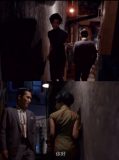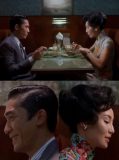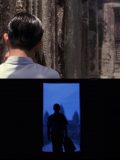Field Trip Script
Intro
G: Hi. I’m GuDian, Ella
X: Hello. I’m Xiong Ruozhu, Ariel. Ella. Do you know what film we are discussing today?
G: Yeah. It’s a romantic film released in 2000 and named In the Mood for Love.
X: Really? The film is older than us. Could you introduce more about it?
G: The film is written and directed by the 42-year-old Hong Kong director Wong Kar-wai. The story was set in 1960s Hong Kong, it illustrated a man (played by Tony Leung) and a woman (played by Maggie Cheung) after discovering that their respective spouses were having an affair, they began to approach each other and subsequently developed feelings for each other. In fact, the plot is quite simple to understand, while the film is highly elliptical, which makes it both subtle and profound in its expression of ideas. Did you notice any application of the concept of architecture we learned in the film?
X: Yeah. After watching it I noticed two concepts, negative space and ordinary landscape. Negative space, also known as white space, is typically empty and devoid of features to help a picture become simpler. It serves several purposes, for instance, in this movie, our eyes can be cushioned and relaxed by the relative simplicity of the images. Therefore, we would only be attracted by areas of positive space in images which could emphasize loneliness through cinematography. Besides, the ordinary landscape means the scenery that people can see everywhere, varying in building type and from city to rural. With a unique vision, we are able to uncover these small landscapes, which represent the characteristics of HK streets but are often overlooked by people.
G: Wow. Thank you for sharing such a wealth of knowledge about camera language. And let’s move to the chosen plots.
First plot
G: The first scene is a chance encounter between the two main characters. It is a stone brick corridor that first appears in the 14th minute of the film. It is narrow at the corridor’s top and wide at its bottom. So that is only possible for two people to pass through the narrow part at once. The setting of the wooden staircase, the stone walls, and the old light bulbs created the famous ‘glimpse of the corridor’ shot. Our hero and heroine had an inevitable physical interaction on the crowded stair though only them two passed by, which implies their implicit love story. At the same moment, the scenario is being played out in a sort of low, dim twilight. The gloomy night symbolizes their inappropriate relationship and the sneakiness of t heir emotions. The use of montage emphasizes the tense relationship between the man and the woman while also attempting to capture the characters’ sense of loneliness.
X: But this staircase we found in Central has been completely transformed. It has become much neater, more spacious and brighter. The staircase has been widened to allow six or seven people to walk side by side at the same time.
G: Yes, the original site has been changed a lot. Ariel, do you have any interesting findings in your chosen plot and site?

Second plot
X: I picked up the plot which described the place where those two main characters ate together. On their first meal, the man wanted to buy the same purse as the woman to give to his wife as a birthday gift which implies they have already discovered that their respective wife and husband had cheated on each other. Then the director used the panning shot to record their second dinner together. In this exchange, although they were seemingly playing the role of each other’s lovers, they actually had gloomy feelings and wanted to comfort both broken hearts. Rather than double-shots, the director uses side close-ups to show that they still exist in their own world and try to ‘arouse’ the feeling that they love each other, but there is still a gap between them.
G: After your explanation, I got a deeper understanding of the complex atmosphere that the director wanted to convey between the two characters. And how about the restaurant currently? Do you find the same place?
X: Unfortunately, no. I found out the location is at 13-15 Lan Fong Road, Causeway Bay. But the former Goldfinch restaurant has been demolished.

Third plot
G: Quite sad to hear that. However, I also didn’t get to check out the second venue I chose.
X: How come?
G: Because the site is in Macau.
X: Really? So which plot do you choose to share?
G: A sad story happened on that site. The deep panoramic shots were used in the third plot: from one end of the corridor to the other end to represent the heavy heart of the man while waiting for the arrival of the heroine after an unethical inviting call. Through the stretching, shifting, blocking, and white space, it could be inferred from the scenes that the hero left alone, and then the woman cried silently in the hotel room where they promised – two people missed each other. Through showing the curtains blown up by the wind and the white space left by the hero as he walked away, providing infinite space for imagining, making the film’s delivery concise while achieving a subtle and timeless artistic effect that is endlessly evocative. It is quite amazing.
X: You said the hotel is in Macau. Has it been deconstructed?
G: I guess not. When I did a search online, I found out some movie fans took pictures with the hotel in recent years and compared it with the hotel in the movie. The decoration and architectural style is similar.

Fourth plot
X: The last shot shows the hero whispering to the tree cave but it’s a stone cave to be honest, while the monk looks down at him from a high position, which is shot from an overhead angle, seemingly with a sense of compassion. Presumably, there is also an allusion to a Buddhist perspective on the multitude of beings, expressing the helplessness of missing out. The theme is sublimated by the tall religious pagoda and the low gutter, showing the humility and helplessness of people bound by a secular view of love. As the narrator says at the end of the film, “The lost years were as if through a dusty glass, visible but ungraspable. He kept missing the past, and if he could break through the dusty glass, he would walk back to the long-lost years.” The feelings between the hero and heroine seem to be within reach, yet isolated far, far away. The beautiful love between them can only be turned into an eternal memory.
G: Such a breathtaking view and a sad story. I know the famous stone scenery. But why did you say the tree cave?
X: Ah~. This is where it echoes the previous episodes. In the earlier story, the hero tells his friend that by telling the secret to the tree hole no one else will know the secret.
G: Oh~. That’s it. I wish I could see that sacred place in person.
X: Yes. Me too.

Conclusion
G: We are nearing the end of this podcast. Do you have anything else you want to share?
X: By analyzing those four scenes, we not only get a clearer idea of where the plot is going, but I think the most important thing is that whether it is the corridor, the restaurant, the hotel, or the tree cave, the architectures in these places have all changed through the passage of time, as well as the changes in the feelings of the hero and heroine.
G: I’m with you. It also hints at the general emotional life and moral values of people in Hong Kong society in the 1960s, showing the contradiction between morality and emotion, the conflict between the colonial and traditional cultures at that time with the complexity and subtlety of human nature. The film’s artistic value is enhanced by giving the film a contemporary color and social significance.
X: And thanks for your time. Bye
G: Bye!
Gu Dian, Ella 3036103066
Xiong Ruozhu, Ariel 3036103781
Reference
Available at: http://xhslink.com/CkKNho (Accessed: March 21, 2023).
Available at: http://xhslink.com/hZeNho (Accessed: March 21, 2023).
「花樣年華」4K版: 官方預告 (2020) YouTube. Available at: https://youtu.be/qpEsGHHm9wA (Accessed: March 21, 2023).
Well done! I appreciate how energetic and natural you two are in the dialogue that engages audiences in your podcast. You have clearly elaborated your ideas and arguments with in-depth analysis on the film plots and how different spaces, such as the alleyways and the restaurants, are used to facilitate the narrative. You have also demonstrated extensive and comprehensive elaborations on the filming techniques and camera language used in the film.
Furthermore, it is impressive to see how you have extended your work by looking into architectural concepts like the idea of negative space to explain the relation of the film and the architecture.